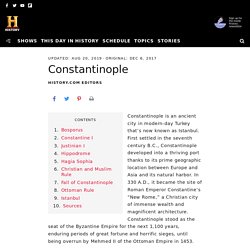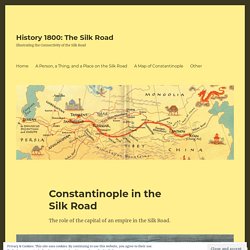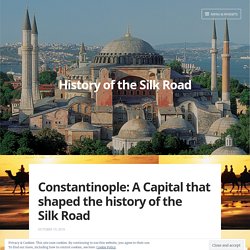

Ye olde travel guide: Constantinople 976 - HistoryExtra. This article was first published in the July 2011 issue of BBC History Magazine When to go Now.

Don’t delay. It will take you a long time to get there from the west and you don’t want to miss the big parade, when Basil II becomes Byzantine emperor in his own right at 18. It’s a huge event – not once-in-a-lifetime, admittedly, since it is perfectly possible that Basil will be blinded or dead in a month and someone else elevated – but still a spectacle concerning the ruler of a superpower. What to take with you The biggest blade you can find and your most trustworthy friends. Make sure you have an interpreter, preferably one who speaks Greek and Arabic. Costs and money This is Constantinople, known as Omphalos, the Navel of the World. Prices will amaze you. It is best not to use hacksilver bits, or torcs or ring money here – the merchants will cheat you with dodgy scales.
Sleeping/accommodation The city will be teeming. Drinking/entertainment Sights and activities Emergencies Istanbul today. Constantinople. Constantinople is an ancient city in modern-day Turkey that’s now known as Istanbul.

First settled in the seventh century B.C., Constantinople developed into a thriving port thanks to its prime geographic location between Europe and Asia and its natural harbor. In 330 A.D., it became the site of Roman Emperor Constantine’s “New Rome,” a Christian city of immense wealth and magnificent architecture. Constantinople in the Silk Road – History 1800: The Silk Road. When the city was renamed Byzantium in the fourth century A.D.[1], the city of Constantinople, located in the heart of the eastern section of the then-Roman Empire, eventually came to be the urban capital of the Byzantine Empire.

This capital of the Byzantine Empire played multiple roles in the kingdom, such as to house the emperor and produce agriculture, enough to partially sustain itself if the city ever came under siege.[2] Another integral role of the city was that Constantinople was an urban nexus of trade, connecting to cities both near and far. Constantinople played a crucial role in the sustainment of the Silk Road in the late Antique and Early Middle Ages, by both importing and exporting various coveted goods, as well as ideals, to and from other countries. Various valuable goods and ideals moved in and out of Constantinople. These goods traded as far as up to hundreds of miles outside of the city walls of Constantinople, and passed through multiple countries.
. [11] Pliny. A very short history of Merchants and Trade in Constantinople. – Rearview Mirror. Constantinople was renowned for its merchants and markets from the 5th to the 10th centuries.

The city attracted in large numbers foreigners who came to buy and sell in its bustling markets especially from the ninth century when Byzantine trade with its neighbours was at its zenith. Today we can only imagine the sound of imperial coins being exchanged from hand to hand or the smell of lotions, perfumed soaps, even the stench of rotting fish on its docks. Constantinople: A Capital that shaped the history of the Silk Road – History of the Silk Road. Constantinople is located in Northern Turkey, and was a city that was founded by Constantine, after he took over Byzantium and renamed it after himself.

Constantine expanded the Roman Empire and took over other territories, such as Byzantium, due to the rise of Christianity in the Empire as well as the flourishing economy due to global trade along the Silk Road. For several reasons, this city played a great role in the cultural, and economic exchange between the East and the West.
One of the largest reasons that Constantinople was such a successful location for trading, was because of its geographical features. It is almost entirely surrounded by water, which was very important for sea trade. Constantinople’s location provides military access to the Mediterranean, Black Sea, Danube River, Dnieper River. Constantinople’s geographical location is how it was able to acquire so much wealth. Constantinople is a place that’s importance is still relevant while analyzing global history today. Silk Roads Programme. It is common to think that the western terminus of the Silk Road was Rome in Italy.

However, whilst Rome was indeed an important destination for Chinese silk during the first two or three centuries of the Silk Road (perhaps until 200 AD), from the 4th century onwards, the “Rome” to which all roads led in the Mediterranean world was “Eastern Rome” or Constantinople.